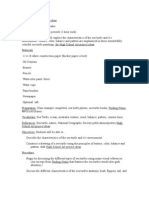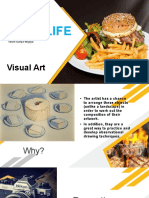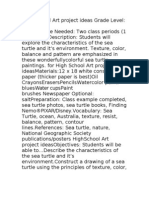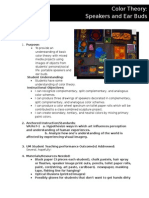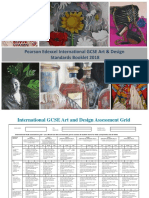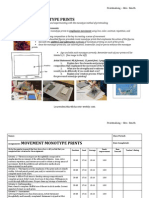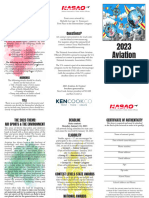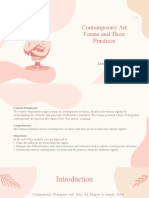Lesson Plan: Curriculum Connections
Lesson Plan: Curriculum Connections
Uploaded by
api-449656775Copyright:
Available Formats
Lesson Plan: Curriculum Connections
Lesson Plan: Curriculum Connections
Uploaded by
api-449656775Original Title
Copyright
Available Formats
Share this document
Did you find this document useful?
Is this content inappropriate?
Copyright:
Available Formats
Lesson Plan: Curriculum Connections
Lesson Plan: Curriculum Connections
Uploaded by
api-449656775Copyright:
Available Formats
Name: Graeme Garland
Lesson Plan
Lesson Title: Still Life drawings Grade: 11 Date: March 10th, 2019
Subject: The Arts Strand: Visual Arts Location: Arts Classroom Time: (number of classes): 2 75 min classes
Lesson Plan Description – (one/two paragraphs with general details about what you will do and how you will do it)
Students will start the class discussing a picture on the board that relates to the class that follows. Then as a class we
will be discussing different works produced over the course of time. Followed up by talking about different techniques,
how to use them, when to use them. Then students will get the opportunity to try out the techniques.
CURRICULUM CONNECTIONS
Ontario Curricular Overall Expectations (numbers from documents and details)
A1. The Creative Process: apply the creative process to create a variety of art works, individually and/or
collaboratively;
A2. The Elements and Principles of Design: apply the elements and principles of design to create art works for the
purpose of self-expression and to communicate ideas, information, and/or messages;
B1. The Critical Analysis Process: demonstrate an understanding of the critical analysis process by examining,
interpreting, evaluating, and reflecting on various art works;
C1. Terminology: demonstrate an understanding of, and use correct terminology when referring to, elements,
principles, and other components related to visual arts;
C2. Conventions and Techniques: demonstrate an understanding of conventions and techniques used in the creation
of visual art works;
Ontario Curricular Specific Expectations (numbers from documents and details) selected & listed from the Ont. Curriculum, refined when
necessary, has verbs that are observable & measureable, has realistic number of expectations (1 to 3) have expectations that match assessment
A1.1 use various strategies, individually and/or collaboratively, to generate, explore, and elaborate on ideas and to
develop and revise detailed plans for the creation of art works that address a variety of creative challenges
A2.1 explore how elements and principles of design can be used to convey emotion and enhance personal expression,
and use a combination of these elements and principles to create two- and three-dimensional art works that express
personal feelings and communicate specific emotions to an audience
B1.1 analyse their initial response to art works
B1.2 deconstruct the visual content and the use of elements and principles of design in their own art work and the
work of others
C1.1 demonstrate an understanding of the elements and principles of design, and use terminology related to these
elements and principles correctly and appropriately when creating or analysing art works
C1.2 explain terminology related to a variety of techniques, materials, and tools, and use this terminology correctly
and appropriately when creating, analysing, and/or presenting art works
C1.3 using appropriate terminology, explain the creative process and describe in detail the critical analysis process,
with particular reference to the role of deconstruction in the latter process
C2.1 demonstrate an understanding of a wide variety of techniques that artists use to achieve a range of specific
effects
Learning Goals Discuss with students: What will I be learning today? (clearly identify what students are expected to know and be able to do, in language
that students can readily understand)
Today I will learn…
What still life art is
How still life art is produced
About historical artist
Drafted by Lakehead University Orillia Faculty of Education Team-August 2013
ASSESSMENT and EVALUATION
Success Criteria Discuss with students: How will I know I have learned what I need to learn? (clearly identify the criteria to assess student’s learning, as well
as what evidence of learning students will provide to demonstrate their knowledge, skills and thinking, in language that students can readily understand)
I can: identify and explain still life art
I can: use techniques to produce still life art
I can: describe past artists and their style
Assessment – how will I know students have learned what I intended?
Achievement Chart Categories (highlight/circle the ones that apply): Knowledge and Understanding; Thinking; Communication; Application
Assessment For, As, Of Learning (Complete the chart below)
Assessment Mode: Assessment Strategy Assessment Tool
Written, Oral, Performance Specific task for students Instrument used to record
(Write, Say, Do) e.g., turn and talk, brainstorming, data
mind map, debate, etc. i.e., rubric, checklist, observation
sheet, etc.
Assessment For Learning Performance Experimenting with Observation sheet
techniques
Assessment As Learning Performance Experimenting with
techniques
Assessment Of Learning
CONSIDERATIONS FOR PLANNING
Prior Learning: Prior to this lesson, students will have
* Grade 9 & 10 Visual Arts
Differentiation: Content, Process, Product, Assessment/Accommodations, Modifications
Attending to all learners, with audio, visual, written, kinesthetic.
Assessments and accommodations will be assessed on a student by student basis some examples include:
A repetition of instructions/ personalized instruction
Use of visuals
One on one help, and guidance towards an idea/ getting them on task
Chunking of information
Learning Skills/Work Habits
Highlight/circle ones that are addressed: responsibility, organization, independent work, collaboration, initiative, self-regulation
Highlight/circle ones that are assessed: responsibility, organization, independent work, collaboration, initiative, self-regulation
Vocabulary (for word wall and/or to develop schema)
Composition
Focal Point
Crop
Blending
Transparent
Opaque
Overlay
Incising
Intensity Change
Value Change
Shadow
Local Colour
Highlight
Reflected light
Drafted by Lakehead University Orillia Faculty of Education Team-August 2013
Core of shadow
Cast shadow
Still Life
Resources and Materials /Technology Integration List ALL items necessary for delivery of the lesson. Include any attachments of student
worksheets used and teacher support material that will support communication of instruction. Include the use of Information Technology (ICT) in your lesson plan
where appropriate.
Smart Board
Computer
Projector
Pencil Crayons
Pastel
Vaseline
Oil
Blending tools
Learning Environment (grouping; transitions; physical set up)
Cross Curricular Links
Lesson – Delivery Format
Write the lesson description with enough detail that another teacher could replicate the lesson without a personal discussion.
What Teachers Do: What Students do:
Minds on: Motivational Hook/engagement /introduction (5-15 min)
Establish a positive learning environment, connect to prior learning, set the context for learning, pre-determine key questions to guide lesson
Time: 0mins – 10 mins (Indicate time breakdown of instructional elements)
Students will be discussing in small groups
Is this a painting, picture or a drawing? whether the image on the smart board is a
Discuss in your groups. painting, picture or a drawing.
Action: During /working on it (time given for each component, suggested 15-40 min)
Introduce new learning or extend/reinforce prior learning, provide opportunities for practice & application of learning
Time: 11mins – 60mins (Indicate time breakdown of instructional elements)
Today we will be talking about Still Life paintings, and we will Students will be listening to the presentation as
see how to use pencil crayons and pastels to reproduce still well as talking about the artwork within the
images. presentation
As we go through the PowerPoint we will be analyzing and
deconstructing the art pieces as a class.
Slide 2: Caravaggio was a pioneer of realistic depiction and
dramatic use of lighting in paintings. He applied his naturalism
to still life and hence Basket of Fruit stands out from previous
paintings in the genre. Apart from its apparently photographic
portrayal, the painting is noted for the spoiled fruits which
appear to have been eaten by insects. Whether the master
painted what was available or was he trying to convey a deeper
meaning is debated.
Slide 3: Active during the Dutch Golden Age, Pieter Claesz was
among the foremost still-life painters of his time. He is famous
for vanitas or still lifes which contain symbols of death or
change as a reminder of their inevitability. This is his most
Drafted by Lakehead University Orillia Faculty of Education Team-August 2013
famous painting. It depicts a plethora of objects most
interestingly a glass sphere in the background which shows
Claesz at the easel, serving as a self-portrait.
Slide 4: Considered an all-time great in still life painting, Jean-
Baptiste Chardin .The Ray was his masterpiece through which
he allured the future generations of artists to still life painting.
The painting contains several novel elements most prominently
the introduction of a living being in the form of a cat. It was
widely studied, admired and copied by future artists including
Henri Matisse.
Slide 5: Vincent Van Gogh is considered a master of still life
paintings and his series of paintings on ‘sunflowers’ rank among
the most famous still life paintings ever created. The paintings
are well known for depicting the natural beauty of the flowers
and for their vibrant colors. This painting smashed the auction
record for a painting when it was sold to a Japanese investor for
almost $40 million in March 1987.
Slide 6: Apart from a brief period in 17th century Northern
Europe, still life was a neglected genre despite the efforts of
Jean-Baptiste Chardin. It was Paul Cezanne who almost single
handedly took it to heights that it became a popular subject for
future artists including Picasso, Matisse, Morandi and Braque.
This painting is a shining example of his artwork in which he
used techniques like two viewpoints which were to change the
direction of art. The painting is also noted for its unbalanced
parts like the titled bottle, inclined basket and the fruits which
are about to fall.
Slide 7: Georges Braque, along with Picasso, co-founded the
dominant art style of the twentieth century, Cubism. Although
he began with landscapes, he shifted to still lifes later. This
masterpiece is an example of Analytic Cubism, the first phase of
Cubism which was short but influential. The elements in the
painting are depicted in simple forms using multiple point-
perspectives and it is painted in monochromatic style, i.e.
different tones of a single color are used.
Slide 8: Deemed as a mother of American Modernism, Georgia
O’Keeffe is known for her paintings of flowers and landscapes.
O’Keeffe’s painted subjects, motifs and forms changed with the
influence of European Modernism. Although many connected
her depictions of iris flower with vulva, she rejected such
Freudian interpretations. However, this did not preclude other
feminist artists to refer to her as their influence, and even Judy
Chicago dedicated a place of her on her Dinner Party piece.
Drafted by Lakehead University Orillia Faculty of Education Team-August 2013
Slide 9: Giorgio Morandi was the leading still life painter of the
twentieth century and among the greatest Italian artists of his
era. His still-lifes are known for their unsophisticated subject
matter, muted colors and simplicity of execution. Marandi used
the same title Natura Morta, which is the Italian term for still
life, for all his works in the genre. The above painting is one of
his many famous works known for their poetic quality and
intensity.
Slide 10: Armand Fernandez, or just Arman, is a French artist
who started out as a painter using traces of ink and paint left by
different objects on his works, to later transfer his interest from
painterly effects to the objects themselves. A member
of Nouveau réalisme, Arman is best known for
his Accumulations – polyester castings filled with different
found stuff, from cutlery, shoes, and clocks, to perfume bottles
and even gas masks. Accumulations resemble traditional still
life paintings with a difference that found stuff here is not
represented but literary present in its plastic cage.
Slide 11: Pop Art Movement emerged in the 1950s and it used
recognizable imagery from popular culture. Among the most
popular works in pop art is Tom Wesselmann’s Still Life series.
His still lifes portray elements of the modern world rather that
the fruits and vegetables of previous generation artists of the
genre. This work (Still Life #30) is a combination of painting,
sculpture and collage of commercial labels Tom found on the
street.
Slide 12: Pop Art is definitely a high art movement where
mundane stuff got the unprecedented prominence. One of the
representatives of the movement, Roy Lichtenstein, created
some of the most striking examples of the type. Famous for his
use of dots and comic book excerpts, Lichtenstein adopted the
same approach in his still life’s.
Slide 13: Born in 1931 in New York City, Audrey Flack’s
adulthood was defined by Civil Rights Movements and Second-
wave feminism. Her painterly work reflects on these social
conditions. Her still life paintings include depictions of jewelry,
perfume bottles, lipstick tubes and other paraphernalia of
femininity. Done in Photorealist style, these paintings still
provoke debates of whether she represented femininity, if
these works show feminist stance, or both at the same instance.
Slide 14: Judy Chicago’s Dinner Party is considered one of the
most significant works of 20th century art. Although it is not
made in traditional technique for the genre, this installation
refers to both tradition of still life paintings and more
Drafted by Lakehead University Orillia Faculty of Education Team-August 2013
importantly to the historical marginalization of women. Table is
set for 39 famous women, and each place-setting has a unique
hand–painted china plate based on vulvar and butterfly forms,
embroidered runners, gold chalice and utensils. The aim of this
exceptional still life installation is, in Chicago’s words, to “end
the ongoing cycle of omission in which women were written out
of the historical record.”
Slide 15: Helpful hints to set up a great composition
• Use an odd number of items (3, 5, 7)
• Create asymmetrical balance in your composition
• Place focal point off center
• Crop, Crop, Crop (get in closed)
Slide 16: Talking about the chart and how to use the chart.
Slide 17: Pencil Crayon techniques
• Transparent: medium is applied in thin layers so paper
texture and colour show through.
• Opaque: medium is applied in heavy layer to create a
solid thick layer of colour.
• Overlay: colours are layered on top of each other of
produce new colours.
• Incising: white lines are firmly drawn on the surface
creating a deep line or texture which shows up when
other colours are smoothly applied over the entire
surface.
• Using Vaseline/oil/marker combination.
Slide 18: Video
http://www.youtube.com/watch?v=vZeuO5ppQpI&feature=fvw
Slide 19: Colouring and Composition Techniques
• Gradation: colours are changed gradually by feathering
and blending
• Value change: light to dark by adding white or black,
called tinting and shading.
• Intensity change: bright to dull by using the pencil
crayon and adding its complementary colour to it (red
Drafted by Lakehead University Orillia Faculty of Education Team-August 2013
to green).
• Cropping: when certain parts of the objects are cut off
or run off the picture plane. This generates a more
interesting composition.
• Do not use black for shading and shadows-use the
opposite colour or a darker version of the colour (red-
shade with dark red or green)
Slide 20:
Local colour: the actual colour of an object.
Highlight: the lightest spot of the object, white tone.
Reflected light: on the underside of an object, is light but not as
bright as the highlight
Shadow: cool, dark area.
Core of shadow: the coolest and darkest area on the form.
Cast shadow: created by complementary overlay
Slide 21-23:
Ideas on what could be used as a still life.
Consolidation & Connection (Reflect and Connect) (5-15 min.)
Help students demonstrate what they have learned, provide opportunities for consolidation and reflection
Time: 61 mins – 75 mins (Indicate time breakdown of instructional elements)
Students will be practicing new techniques in
At this time students will have the opportunity to try out the preparation of final assignment
new techniques in order to get the feeling for how to do it in
preparation for their assignment on still life.
Extension Activities/Next Steps (where will this lesson lead to next)
Assignment for still life drawings
Personal Reflection (what went well, what would I change, what will I have to consider in my next lesson for this subject/topic)
The Lesson:
The Teacher:
Drafted by Lakehead University Orillia Faculty of Education Team-August 2013
You might also like
- Bisa Butler Handout 1Document5 pagesBisa Butler Handout 1api-510900825100% (1)
- 517 Sequencing of Lessons Ninasiska PDFDocument8 pages517 Sequencing of Lessons Ninasiska PDFapi-288986589No ratings yet
- Art21 Season One Guide-1Document36 pagesArt21 Season One Guide-1chuleta390% (1)
- Visual Arts Year 10 Portrait Curriculum PlannerDocument20 pagesVisual Arts Year 10 Portrait Curriculum Plannerapi-425263155No ratings yet
- Pacing Calendar1Document2 pagesPacing Calendar1api-248994847No ratings yet
- High School Art Project IdeasDocument3 pagesHigh School Art Project IdeasVolans100% (2)
- Ci-Miniunit-Abstract ArtcolorDocument13 pagesCi-Miniunit-Abstract Artcolorapi-299713215No ratings yet
- Unit Highschool Draft Final - Charles BoswellDocument5 pagesUnit Highschool Draft Final - Charles Boswellapi-458154077No ratings yet
- Wire Sculpture Lesson PlanDocument4 pagesWire Sculpture Lesson Planapi-439274434No ratings yet
- Unit Plan - A Picture Is Worth A Thousand WordsDocument6 pagesUnit Plan - A Picture Is Worth A Thousand Wordsapi-179932728No ratings yet
- Cleaning of Oil PaintingsDocument22 pagesCleaning of Oil PaintingsNeetu Zee100% (2)
- ASTM D3276 - 07 Standard Guide For Painting Inspectors PDFDocument14 pagesASTM D3276 - 07 Standard Guide For Painting Inspectors PDFFCT80% (5)
- Lesson Plan: Curriculum ConnectionsDocument5 pagesLesson Plan: Curriculum Connectionsapi-449656775No ratings yet
- Circle ArtDocument12 pagesCircle Artapi-310441633No ratings yet
- Lesson Plan Grade) : Pre-AssessmentDocument8 pagesLesson Plan Grade) : Pre-Assessmentapi-310487485No ratings yet
- Lesson Plan: Curriculum ConnectionsDocument4 pagesLesson Plan: Curriculum Connectionsapi-449656775No ratings yet
- Year 7 Portraits 090615Document9 pagesYear 7 Portraits 090615api-323904546No ratings yet
- Still Life DrawingDocument26 pagesStill Life DrawingLeony PanjaitanNo ratings yet
- High School Art Project Ideas Grade LevelDocument7 pagesHigh School Art Project Ideas Grade LevelRachelBarrera0% (2)
- Grade: 7 Lesson Title: Cartooning (Comic Strips) Lesson Duration: 75 MinutesDocument3 pagesGrade: 7 Lesson Title: Cartooning (Comic Strips) Lesson Duration: 75 Minutesapi-544731570No ratings yet
- Self Portrait Rubric Art IDocument1 pageSelf Portrait Rubric Art IJenESmith100% (2)
- Lesson Plan - PicassoDocument6 pagesLesson Plan - Picassoapi-298982688100% (1)
- Still Life: Mr. Dorofy'S Art Room Es3Document14 pagesStill Life: Mr. Dorofy'S Art Room Es3Jason DorofyNo ratings yet
- PopunitDocument13 pagesPopunitapi-272772705No ratings yet
- Unit Color TheoryDocument5 pagesUnit Color Theoryapi-255551803No ratings yet
- Lesson Plan Art Fundamentals 3Document7 pagesLesson Plan Art Fundamentals 3api-490426183No ratings yet
- Exploring Still Life: 6th Grade Unit PlanDocument68 pagesExploring Still Life: 6th Grade Unit Planapi-548946265No ratings yet
- What Is Artist StatementDocument2 pagesWhat Is Artist StatementRabia Rehman100% (1)
- New Spec Art Design Exemplars Component 2Document98 pagesNew Spec Art Design Exemplars Component 2ivancov catalinNo ratings yet
- Art 2 Syllabus 2019Document3 pagesArt 2 Syllabus 2019sbmangerNo ratings yet
- Scope and Sequence Plan Stage5 Year9 Visual ArtsDocument5 pagesScope and Sequence Plan Stage5 Year9 Visual Artsapi-254422131No ratings yet
- Scratchboard Art Project DirectionsDocument3 pagesScratchboard Art Project DirectionsDJacobson100% (2)
- Art LessonDocument3 pagesArt Lessonapi-303068384No ratings yet
- Introduction To Art AppreciationDocument9 pagesIntroduction To Art AppreciationJewel SkyNo ratings yet
- Surreal Perspective Lesson PlanDocument9 pagesSurreal Perspective Lesson Planapi-220176001No ratings yet
- Lesson Plan Looking at Art - Introduction To Art Criticism 3Document11 pagesLesson Plan Looking at Art - Introduction To Art Criticism 3api-448816945100% (1)
- What Does Art MeanDocument3 pagesWhat Does Art MeanMohsin AzizNo ratings yet
- Color Book Unit PlanDocument35 pagesColor Book Unit Planapi-296423521No ratings yet
- Completing The Picture Lesson PlanDocument7 pagesCompleting The Picture Lesson Planapi-301610303No ratings yet
- Expressive Self-Portrait RubricDocument1 pageExpressive Self-Portrait Rubricapi-242180830No ratings yet
- Unit 2 Otcome 1 Vce RubricDocument2 pagesUnit 2 Otcome 1 Vce Rubricapi-246589904100% (1)
- Amorphous Shape Lesson PlanDocument2 pagesAmorphous Shape Lesson Planspektorish100% (1)
- Printmaking Unit PlanDocument73 pagesPrintmaking Unit Planapi-336834648No ratings yet
- Op-Art OverviewDocument2 pagesOp-Art Overviewapi-233109765No ratings yet
- Movement Monotype Printsand RubricDocument2 pagesMovement Monotype Printsand Rubricapi-2521667880% (1)
- Ba Hons Painting HandbookDocument32 pagesBa Hons Painting HandbookekibentoNo ratings yet
- Gcse Landscape Project 12 Week Plan UpdatedDocument9 pagesGcse Landscape Project 12 Week Plan Updatedapi-442506422No ratings yet
- Pointillism Lesson 400Document17 pagesPointillism Lesson 400api-548946265No ratings yet
- Clay House Lesson Plan Grade 6 Webb PDFDocument11 pagesClay House Lesson Plan Grade 6 Webb PDFapi-348662273No ratings yet
- Art History CurriculumDocument2 pagesArt History CurriculumHeather100% (1)
- Long Range Plans - Art 30Document5 pagesLong Range Plans - Art 30api-523925517100% (1)
- Semester Overview Arts Visual Arts Year 1 2012-2013Document2 pagesSemester Overview Arts Visual Arts Year 1 2012-2013api-185034533No ratings yet
- NAEA Standards For Art Teacher PrepDocument24 pagesNAEA Standards For Art Teacher PrepZack SoetejaNo ratings yet
- Arts Integration Lesson PlanDocument6 pagesArts Integration Lesson Planapi-434604005No ratings yet
- Parodypainting 4Document5 pagesParodypainting 4api-282873721No ratings yet
- Atmospheric Perspective LessonDocument2 pagesAtmospheric Perspective Lessonapi-282591456No ratings yet
- Chuck Close Inspired Portrait RubricDocument2 pagesChuck Close Inspired Portrait Rubricapi-260853196No ratings yet
- Year 7 U1 Visual Arts Myp Assessment Task and RubricDocument3 pagesYear 7 U1 Visual Arts Myp Assessment Task and Rubricapi-320846565100% (1)
- Unit Plan - Art 30 - DrawingDocument5 pagesUnit Plan - Art 30 - Drawingapi-523925517No ratings yet
- Okeeffe Oil Pastels Lesson PlanDocument2 pagesOkeeffe Oil Pastels Lesson PlanspektorishNo ratings yet
- Elements of ArtDocument32 pagesElements of Artjadygordon6No ratings yet
- Streetartlessonplan 1Document16 pagesStreetartlessonplan 1api-335950861No ratings yet
- HL Unit Planner MYP2 Mask Making 2012Document3 pagesHL Unit Planner MYP2 Mask Making 2012avalanchequeenNo ratings yet
- The Beliefs of An Aspiring Teacher - Garland GraemeDocument4 pagesThe Beliefs of An Aspiring Teacher - Garland Graemeapi-449656775No ratings yet
- History Lesson - Lesson Plan - Graeme GarlandDocument5 pagesHistory Lesson - Lesson Plan - Graeme Garlandapi-449656775No ratings yet
- Lesson Plan: Curriculum ConnectionsDocument3 pagesLesson Plan: Curriculum Connectionsapi-449656775No ratings yet
- Short Story Lesson PlanDocument3 pagesShort Story Lesson Planapi-449656775No ratings yet
- Lesson Plan: Curriculum ConnectionsDocument6 pagesLesson Plan: Curriculum Connectionsapi-449656775No ratings yet
- Lesson Plan: Curriculum ConnectionsDocument5 pagesLesson Plan: Curriculum Connectionsapi-449656775No ratings yet
- Seven Elements of PaintingDocument2 pagesSeven Elements of PaintingJulian Albert Nohay78% (9)
- Crayons PaintingDocument4 pagesCrayons Paintingesa_arunNo ratings yet
- Bl-Ge-6115-Lec-1923t Art AppreciationDocument4 pagesBl-Ge-6115-Lec-1923t Art AppreciationjikjikNo ratings yet
- Avn 2023 Art ContestDocument2 pagesAvn 2023 Art ContestMarisolNo ratings yet
- CPAR - Na 13 14Document21 pagesCPAR - Na 13 14Rializa Caro BlanzaNo ratings yet
- The Layers of Portrait Painting With Joshua LaRock - Supplemental PDFDocument5 pagesThe Layers of Portrait Painting With Joshua LaRock - Supplemental PDFAlison De Sando ManzoniNo ratings yet
- Graffiti Art ReadingDocument3 pagesGraffiti Art ReadingBudNo ratings yet
- John PadmoreDocument5 pagesJohn PadmoreluciamunozbarrenaNo ratings yet
- Pub - The Art of Color PDFDocument113 pagesPub - The Art of Color PDFAnh Thư100% (1)
- Exercise/S: Name: Lucero, Marey Kaye C. Subject: Art Appreciation Year & Section: Bscrim2 Section A Instructor: Mrs. Cristy May B. SaliseDocument2 pagesExercise/S: Name: Lucero, Marey Kaye C. Subject: Art Appreciation Year & Section: Bscrim2 Section A Instructor: Mrs. Cristy May B. SaliseMonica MateoNo ratings yet
- The Peninsula Manila by Ben CabreraDocument2 pagesThe Peninsula Manila by Ben CabreraEvaNo ratings yet
- Painting - Realism, Impressionism and BeyondDocument5 pagesPainting - Realism, Impressionism and BeyondBGRNo ratings yet
- Social Realism ArtworksDocument24 pagesSocial Realism ArtworksMN TeNo ratings yet
- Rva Lesson 2Document9 pagesRva Lesson 2Jerome BarojaNo ratings yet
- 10 Final Mapeh Arts 10 q2 g10 M 2 - Week 4Document16 pages10 Final Mapeh Arts 10 q2 g10 M 2 - Week 4Mark Glenn NadelaNo ratings yet
- Art AppreciationDocument8 pagesArt Appreciationlhanilyn buhayNo ratings yet
- HUM 113 - 6 Artists and ArtisansDocument11 pagesHUM 113 - 6 Artists and ArtisansShiela ZanneNo ratings yet
- Impressionism QuizDocument2 pagesImpressionism QuizRazen Mae Dagaraga100% (3)
- Lesson 1 - Contemporary Art Forms and Their PracticesDocument36 pagesLesson 1 - Contemporary Art Forms and Their PracticesBombasi Jhenra Prysilla AlishaNo ratings yet
- LAYAGUE - Local Interview ProjectDocument10 pagesLAYAGUE - Local Interview ProjectCHRISTIAN JANUS LAYAGUENo ratings yet
- American Artists On Art From 1940 To 1980Document290 pagesAmerican Artists On Art From 1940 To 1980Sima Roxana100% (2)
- Amoako Boafo 2023 What Could Possibly Go Wrong If We Tell It Like It Is Gagosian 980 Madison AvenueDocument2 pagesAmoako Boafo 2023 What Could Possibly Go Wrong If We Tell It Like It Is Gagosian 980 Madison AvenueLuiz Sergio da Cruz de OliveiraNo ratings yet
- Gustave CourbetDocument26 pagesGustave CourbetsubirNo ratings yet
- Pop ArtDocument6 pagesPop ArtShowbiz ExposeNo ratings yet
- Afro Modern: Journeys Through The Black AtlanticDocument22 pagesAfro Modern: Journeys Through The Black AtlanticPaul MiersNo ratings yet
- Art in The International Encyclopedia of GeographyDocument9 pagesArt in The International Encyclopedia of GeographyRipped CrinkleNo ratings yet





